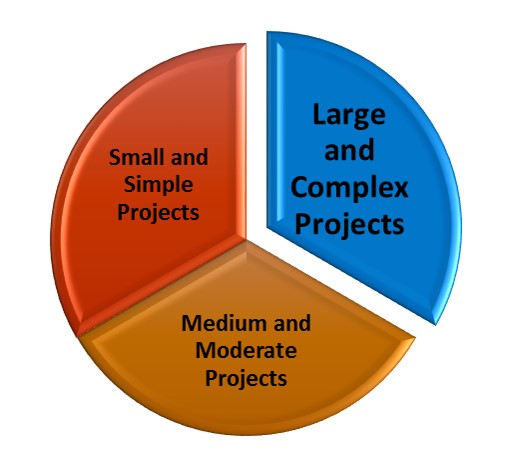This is a part of a chapter from our upcoming book in Integrated City Project, a sample – large and complex project. The book is about how to use The Customizable and Adaptable Methodology for Managing Projects™ (CAM2P™) on such a project.
Introduction
Project classification and a classification system requires a great deal of focus, which outside the scope of this book (or this article). From a methodology perspective, CAM2P™ (The Customizable and Adaptable Methodology for Managing Projects™) considers three simplified classifications. Please note, these can be highly dependent on the context of the organizations adopting this approach.
 Small and Simple Projects
Small and Simple Projects
These are typically small[1] projects, requiring a few resources, relatively short duration and with limited complexity.
For these projects, the recommendation is to either use CAM2P™ project life span without the process groups or use the process groups without a project life span. In other words, make the project life span somewhat equivalent to process groups although theoretically this is not correct, yet it is a practical approach.
This is the approach used on the Writing a Book Project sample discussed in the Applied Project Management book, currently being published.
Medium and Moderate Projects
These would be bigger projects and with moderate complexity[2].
For these projects, the recommendation is to use a project life span approach with the process groups repeating. In these projects, the process groups may not be required in every phase since some phases and stages could be simple and require only some of the processes, whereas other stages could require the repetition of all of the process groups and processes.
Large and Complex Projects
These would be the largest and most complex projects that an organization handles.
For these projects, it is highly recommended to use the full CAM2P™ model integrating the process groups repeating in every stage.
The rest of this book is a great match for this approach. However, we must stress, that a project does not have to be as large and complex as what we present in this book. As we said earlier, this project, the Integrated City Project is more of a program rather than a project. Yet, CAM2P™ still applies on the full project or even a piece of it, like the airport, port, rail road, or the community. Each of these component is a large and complex project by itself.
Would love to hear from you. Do you use a classification system in your organization? What can you share about it?
[contact-form][contact-field label=’Name’ type=’name’ required=’1’/][contact-field label=’Email’ type=’email’ required=’1’/][contact-field label=’Website’ type=’url’/][contact-field label=’Comment’ type=’textarea’ required=’1’/][/contact-form]
[1] Size – is relative to the organizational context
[2] Again, defining these is outside the scope of this book

Trackbacks/Pingbacks